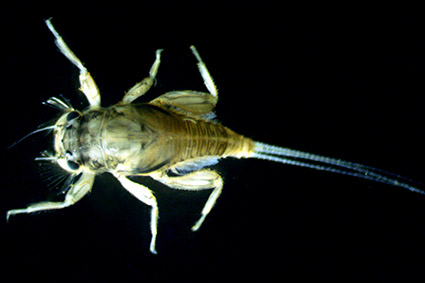Abstract
Sparsorythus srokai sp. nov. is described from the Veerapandi River, Theni district, Tamil Nadu, India based on nymphs of both sexes. The nymphs of Sparsorythus srokai sp. nov. can be distinguished by the following combination of characters: i) presence of lateral setae in each segment of caudal filaments, ii) dorsal surface of labrum entirely covered with scattered ribbon-like bristles, iii) posterior margin of mesonotum reaching abdominal segment III in both sexes, and iv) left prostheca with several pointed teeth apically. The new species is compared with other Indian species: S. gracilis Sroka & Soldán, 2008, S. sivaramakrishnani Sivaruban, Srinivasan, Barathy, Rosi & Isack, 2021 and S. nanjangudensis Muthukatturaja & Balasubramanian, 2021. The distributional map and key to the genus Sparsorythus in Southern India are also given.
References
Barber-James, H.M. (2008) A synopsis of the Afrotropical Tricorythidae, In: Hauer, F.R., Stanford, J.A. & Newell, R.L. (Eds.), International Advances in the Ecology, Zoogeography, and Systematics of Mayflies and Stoneflies. University of California Press, Berkeley and Los Angeles, California, pp. 187–203. https://doi.org/10.1525/california/9780520098688.003.0014
Barber-James, H.M., Gattoliat, J.L., Sartori, M. & Hubbard. M.D. (2008) Global diversity of mayflies (Ephemeroptera, Insecta) in freshwater. Hydrobiologia, 595, 339–350. https://doi.org/10.1007/s10750-007-9028-y
Batucan, L.S., Nuñeza, O.M., Villanueva, R.J.T. & Lin, C.P. (2016) A new species of mayfly (Ephemeroptera: Tricorythidae) from Mindanao Island, Philippines and association of life stages using DNA barcodes. Philippine Journal of Systematic Biology, 10, 6–13. https://doi.org/10.26757/pjsb.201610002
Demoulin, G. (1954) Recherches critiques sur les Ephéméroptères Tricorythidae d’Afrique et d’Asie. Bulletin et Annales de al Société Royale d’Entomologie de Belgique, 90, 264–277.
Eaton, A.E. (1868) An outline of a re-arrangement of the genera of Ephemeridae. Entomologist’s Monthly Magazine, 5, 82–91.
Elouard, J.-M. & Oliarinony, R. (1997) Biodiversité aquatique de Madagascar. 6 Madecassorythus un nouveau genre de Tricorythidae définissant la nouvelle sous-famille des Madecassorythinae (Ephemeroptera, Pannota). Bulletin de la Société entomologique de France, 102 (3), 225–232. https://persee.fr/doc/bsef_0037928x_1997_num_102_3_17335
Garces, J.M., Bauernfeind, E. & Freitag, H. (2018) Sparsorythus sescarorum, new species from Mindoro, Philippines (Ephemeroptera, Tricorythidae). ZooKeys, 795, 13–30. https://doi.org/10.3897/zookeys.795.28412
Kluge, N.J. (2010) Redescription of the taxón Tricorygnatha (Ephemeroptera, Tricorythus s.l.) based on new findings in Africa and Indonesia. Russian Entomological Journal, 19 (2), 79–104. https://doi.org/10.15298/rusentj.19.2.01
Lestage, J.A. (1942) Contribution à l’étude des Ephéméroptères. XXV. Notes critiques sur les anciens Caenidiens d’Afrique et sur l’indépendance de l’évolution tricorythido-caenidienne. Bulletin du Musée royal d’histoire naturelle de Belgique, XVIII 48, 20 pp.
Muthukatturaja, M. & Balasubramanian, C. (2021) A new species of Sparsorythus Sroka & Soldán, 2008 (Ephemeroptera: Tricorythidae) from Western Ghats, Southern India. Zootaxa, 5040 (3), 437–447. https://doi.org/10.11646/zootaxa.5040.3.8
Oliarinony, R. & Elouard, J.-M. (1997) Biodiversité aquatique de Madagascar: 7 Ranorythus, un nouveau génre de Tricorythidae définissant la nouvelle sous-famille der Ranorythinae (Ephemeroptera, Pannota). Bulletin de la Société entomologique de France, 102 (5), 439–447.
Oliarinony, R., Elouard, J.-M. & Raberiaka, N. (1998) Biodiversité aquatigue de Madagascar: 8—Spinirythus, un nouveau genre de Tricorythidae (Ephemeroptera Pannota). Bulletin de la Société entomologique de France, 103 (3), 237–244.
Pictet, F.J. (1843–1845) Histoire naturelle générale et particulaire des Insectes Névroptères Seconde Monographie: Famille des Ephemerines. Baillière édit., Paris and Kessmann et Cherbuliez édit., aussi à Genève, x + 300 pp., 47 pls. https://doi.org/10.5962/bhl.title.48625
Piraonapicha, K. & Sangpradub, N. (2019) Description of nymphs and female subimago of Sparsorythus multilabeculatus Sroka & Soldán, 2008 (Ephemeroptera: Tricorythidae) associated with male imago based on DNA sequence data. Zootaxa, 4695 (6), 501–515. https://doi.org/10.11646/zootaxa.4695.6.1
Shorthouse, D.P. (2010) SimpleMappr, an online tool to produce publication-quality point maps. https://www.simplemappr.net (accessed 6 April 2021)
Sivaruban, T., Srinivasan, P., Barathy, S., Rosi, M.B. & Isack, R. (2021) A new species of Sparsorythus Sroka & Soldán, 2008 (Ephemeroptera: Tricorythidae) from Eastern Ghats of Southern India. Zootaxa, 4915 (2), 237–245. https://doi.org/10.11646/zootaxa.4915.2.3.
Sroka, P. & Soldán, T. (2008) The Tricorythidae of the Oriental Region, In: Hauer, F.R. Stanford, J.A. & Newell, R.L. (Eds.), International Advances in the Ecology, Zoogeography, and Systematics of mayflies and stoneflies. University of California Press, Berkeley and Los Angeles, California, pp. 313–354. https://doi.org/10.1525/california/9780520098688.003.0021
Ulmer, G. (1913) Ephemeridenaus Java, gesammelt von Edw. Jacobson. Notes from the Leyden Museum, 35, 102–120.
Venkataraman, K. & Sivaperuman, C. (2018) Biodiversity hotspots in India. In: Sivaperuman, C. & Venkataraman, K. (Eds.), Indian Hotspots. Springer, Singapore, pp. 1–27. https://doi.org/10.1007/978-981-10-6605-4_1


